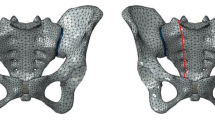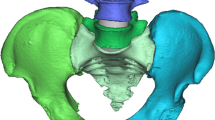Abstract
Purpose
This study aimed at comparing the risk of breakage of lengthened sacroiliac screw and ordinary sacroiliac screw for the treatment of bilateral vertical sacral fractures to provide reference for clinical application.
Methods
A finite element model of type C pelvic ring injury (bilateral type Denis II fracture of sacrum) was produced. The bilateral sacral fractures were fixed with lengthened sacroiliac screw and ordinary sacroiliac screw in seven types of models, respectively. The maximal Von Mises stresses and stress distribution of the two kinds of screws in the case of standing on both feet were measured and compared.
Results
(1) Whether in lengthened sacroiliac screw or ordinary sacroiliac screw, the maximal Von Mises stress of screw fixation only in S1 segment is the largest, and the maximal Von Mises stress of screw fixation only in S2 segment is minor, and the maximal Von Mises stress of screw fixation in S1 and S2 segments, respectively, is the least. (2) When S1 and S2 were both fixed with ordinary screws, the maximal Von Mises stress of screw in S1 segment is larger than that of S2. When S1 and S2 were both fixed with lengthened screws, the maximal Von Mises stress of screw in S1 segment is similar to that of S2. (3) The maximal Von Mises stresses of bilateral symmetrical screws are similar. (4) When only S1 was fixed, the maximal Von Mises stress of lengthened screw is less than that of ordinary screw. When only S2 was fixed, the maximal Von Mises stress of lengthened screw is larger than that of ordinary screw. When S1 and S2 were both fixed, the maximal Von Mises stress of lengthened screw is slightly less than that of ordinary screw. (5) Whether in lengthened screw or ordinary screw, the stress concentrations all exhibited at the regions of screws corresponding to the sacral fracture regions and the part between sacral bilateral fracture lines. Compared with ordinary screw, the stress distribution in lengthened screw is more homogeneous. Whether in lengthened screw or ordinary screw, the stress distribution of only one sacral segment fixation is more concentrated than that of two sacral segments’ fixation. When S1 and S2 were both fixed, the stress distribution of upper screw is more concentrated and that of lower screw is more homogeneous.
Conclusion
In a finite elements simulated type C pelvic ring disruption (bilateral type Denis II sacral fracture), the breakage risk of screws fixed in double-segment bilaterally symmetrically is low, and the breakage risk of screws fixed in S2 segment is lower than that of S1 segment. The bilaterally symmetrical screw fixation in double-segment is strongly recommended to reduce the breakage risk of screws. In addition, the breakage risk of lengthened screws is lower than that of ordinary screws except when screws are fixed in only S2 segment, which merits attention.






















Similar content being viewed by others
References
Osterhoff G, Ossendorf C, Wanner GA et al (2011) Percutaneous iliosacral screw fixation in S1 and S2 for posterior pelvic ring injuries: technique and perioperative complications. Arch Orthop Trauma Surg 131:809–813
Thambiraj S, Forward DP, Thomas J et al (2012) A novel “pelvic ring augmentation construct” for lumbo-pelvic reconstruction in tumour surgery. Eur Spine J 21:1797–1803
Hu X, Pei F, Wang G et al (2013) Application triangular osteosynthesis for vertical unstable sacral fractures. Eur Spine J 22:503–509
Zhao Y, Li J, Wang D et al (2012) Comparison of stability of two kinds of sacroiliac screws in the fixation of bilateral sacral fractures in a finite element model. Injury 43:490–494
Phillips AT, Pankaj P, Howie CR et al (2007) Finite element modelling of the pelvis: inclusion of muscular and ligamentous boundary conditions. Med Eng Phys 29:739–748
Dakin GJ, Arbelaez RA, Molz FJ 4th et al (2001) Elastic and viscoelastic properties of the human pubic symphysis joint: effects of lateral impact joint loading. J Biomech Eng 123:218–226
García JM, Doblaré M, Seral B et al (2000) Three-dimensional finite element analysis of several internal and external pelvis fixations. J Biomech Eng 122:516–522
Tornetta P III, Jacofsky DJ, Jaczynski AM et al (2009) Trans-sacral screw fixation of stable zone 2 sacral fractures. In: Scientific poster 18 presented at the 25th annual meeting of the Orthopaedic Trauma Association, San Diego. Available at: http://www.hwbf.org/ota/am/ota09/otapo/OTP09018.htm. Accessed 26 Jan 2010
Acknowledgments
This research is supported by the Natural Science Foundation of China (Grant No. 81301553) and the Young and Middle-Aged Scientists Research Awards Foundation of Shandong Province, China (No. BS2013SF015).
Conflict of interest
None.
Author information
Authors and Affiliations
Corresponding author
Rights and permissions
About this article
Cite this article
Fu, S., Zhao, Y., Lian, W. et al. Comparison of the risk of breakage of two kinds of sacroiliac screws in the treatment of bilateral sacral fractures. Eur Spine J 23, 1558–1567 (2014). https://doi.org/10.1007/s00586-014-3313-z
Received:
Revised:
Accepted:
Published:
Issue Date:
DOI: https://doi.org/10.1007/s00586-014-3313-z




